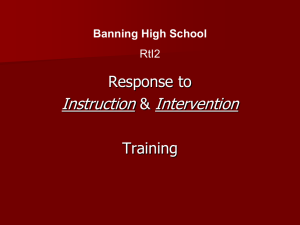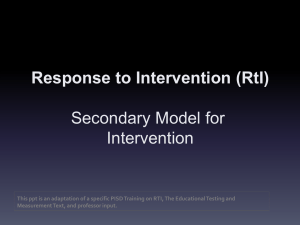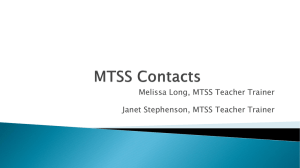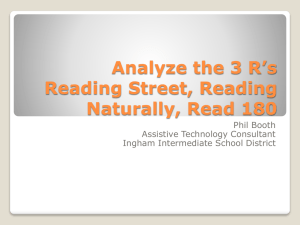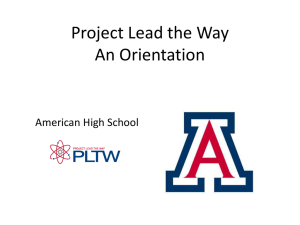Response to Intervention
advertisement
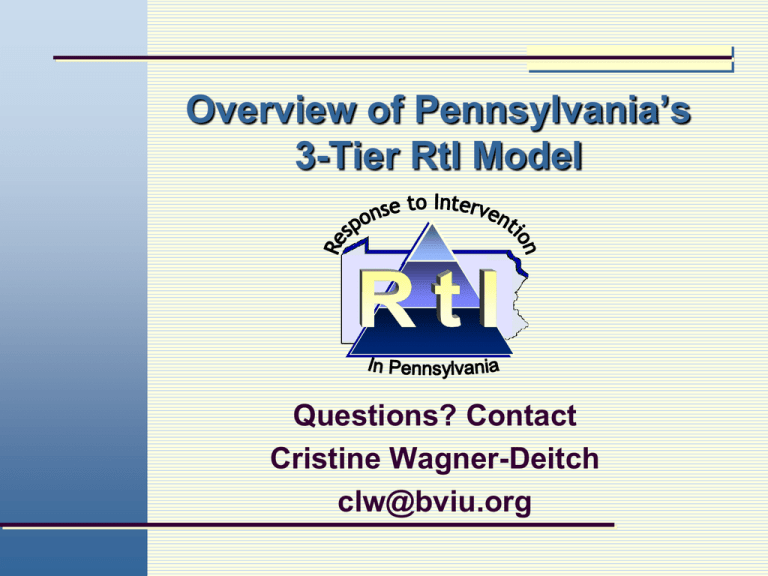
Overview of Pennsylvania’s 3-Tier RtI Model Questions? Contact Cristine Wagner-Deitch clw@bviu.org What Is Response to Intervention? A comprehensive, multi-tiered intervention strategy to enable early identification and intervention for students at academic or behavioral risk. An alternative to the discrepancy model for the identification of students with learning disabilities. Key Characteristics of RtI Universal Screening of academics and behavior Multiple tiers of increasingly intense interventions Differentiated curriculum-tiered intervention strategy Use of scientifically research-based interventions Continuous monitoring of student performance Benchmark/Outcome assessment Past and Current Practices to RtI Where we have been … Where we are going… Resources Gained 1990-2007 Referral for At Risk Students Request for assistance by teacher or parent Student specific team IST (support) teacher coordinates process Standards-based core curriculum presumed Implemented customized effective instruction for students at-risk Implications for whole group instruction Behavior problems addressed through “Valentine” model and “Initial Line of Inquiry” Progress monitoring for students at-risk Pre-referral system-led to evaluation if needed Parent awareness Elementary student assistance program (ESAP) embedded in IST functions Teams use problem-solving format Identification of need by universal screening for all students • Academic Standards • PSSA/PASA School, grade, group and, student specific flexible and fluid teams • Access to General Education Curriculum Coordination required for each team and between teams across the school • Curriculum Aligned with Academic Standards Requires research-based core curriculum for reading and math • Scientific Research Base • State-wide Emphasis on Data-Informed DecisionMaking Student specific targeted ‘strategies’ Targeted instructional ‘strategies’ (with available research-based interventions) Response to Intervention for Requires effective instructional practices for all students School, grade, group and student specific interventions for all students • PVAAS • State-wide Dibels Training & Support for All Students • State-wide Positive Behavior Support Training • State-wide Progress Monitoring Training • Tutoring & Extended Learning Opportunities • Assessment Anchors Data from process can be used as part of primary SLD diagnostic criteria • Focus on All Students-All Subgroups Extensive parent involvement & reinforcement between home and school • School Improvement Model • Inclusive Practices Schools decide on relationship of three-tier process and ESAP Scientific research-based interventions and standard protocol interventions Systematic changes in whole group instruction – differentiated instruction Behavior problems addressed through positive behavior supports Progress monitoring for all students at varying intensity Teams use problem-solving format with scientific base and consistent data Beaver County’s Three-tiered Model An Integrated Approach (General, Remedial and Special Education) Based upon a functional perspective Focused on academic/behavioral growth of all students Student needs exist on a continuum Resources organized and provided in direct proportion to student need Implementation Scientifically research-based practices Problem Solving Model A “Best Practice” approach Considers all system variables (child, teacher, environment) Results in objective and measurable interventions (evidence-based… “n of 1”) Beaver County’s Three-tiered Model Tier I Universal School-Wide Supports Tier II Selected and Targeted Interventions Tier III Intensive Interventions Tier 1: Benchmark/Schoolwide Definition: Students who are making expected progress in the general education curriculum and who demonstrate social competence Benchmark also describes those school-wide interventions that are available to all students Effective instruction Clear expectations Effective student support Periodic benchmark assessments Universal prevention Tier 1 Functions Universal Screening Data Analysis teaming School-wide Behavior Supports Whole Group Teaching Tier 1: Benchmark/Schoolwide Universal Prevention, Screening, Monitoring High quality instructional and behavioral supports are provided for all students in general education Teachers implement a variety of scientifically research-based teaching strategies and approaches School personnel conduct universal screening of literacy skills, academics, and behavior Students receive differentiated instruction based on data from ongoing assessments Adapted from: Kovaleski (2005). Special Education Decision Making [ppt.] Tier I: Effective Teaching Principles Engaged Time Critical forms of knowledge High Success Rates Opportunity to Learn Content Direct and Supervised Teaching Organizing, storing and retrieving knowledge Strategic Instruction Explicit Instruction Scaffolded Instruction Tier 1: Benchmark/School-wide Examples: Strategic/Interventions Core Instructional Program Available to all students in general education curriculum Differentiated instruction within the core curriculum School-wide Effective Behavior Supports (SWEBS) Tier 1: Benchmark/School-Wide Core Reading Programs 1. 2. 3. 4. 5. 6. 7. 8. 9. Rigby Literacy (Harcourt Rigby Education, 2000) Trophies (Harcourt School Publishers, 2003) The Nation’s Choice (Houghton Mifflin, 2003) Macmillan/McGraw-Hill Reading 2003 Open Court (SRA/McGraw-Hill, 2002) Reading Mastery Plus (SRA/McGraw-Hill, 2002) Scott Foresman Reading, 2004 Success for All 1998-2003 Wright Group Literacy 2002 Reviewed by: Oregon Reading First, Comprehensive: Addressed all 5 areas and included at least grades K-3. Tier 1: Benchmarks/School-wide Florida Center for Reading Research: www.fcrr.org Oregon Reading First Center: http://reading.uoregon.edu Texas Center for Reading and Language Arts: www.texasreading.org Results of Tier 1 Continue effective practices for responders Non-responders begin tier 2 interventions Tier 2: Strategic/Targeted Definition: Academic and behavioral strategies, methodologies and practices designed for students not making expected progress in the general education curriculum and/or have mild to moderate difficulties demonstrating social competence. These students are at risk for academic failure. Tier 2: Strategic Interventions Use of standard protocol interventions Scientifically research-based interventions Academically – reading & math Behavior Core instruction with supplemental materials Differentiated instruction in general ed. Specialists assist with strategic instruction in regular classroom A Standard Protocol Intervention… Is scientifically researched-based. Has a high probability of producing change for large numbers of students. Is designed to used in a standard manner across students. Is usually delivered in small groups. Is often scripted or very structured. Can be orchestrated by a problem-solving team. Tier 2: Strategic Interventions (cont.) Increased opportunity to learn Increased instructional time Increased assessment Data collection and analysis once per month Data-based decision-making Tier 2: Strategic/Supplemental Reading Programs 1. Early (soar to) Success (Houghton Mifflin) 2. Read Well (Sopris West) 3. Reading Mastery (SRA) 4. Early Reading Intervention (Scott Foresman) 5. Great Leaps (Diamuid, Inc) 6. REWARDS (Sopris West) 7. Ladders to Literacy (Brookes) Read Naturally 8. Peer Assisted Learning Strategies (PALS) Results of Tier 2 Interventions Cycle responders back to tier 1 Identify non-responders for tier 3 Without Response to Intervention Special Education Sea of Ineligibility General Education RtI – Bridging the GAP Amount of Resources Needed to Solve Problem Special Education Interventions General Education Intensity of Problem RtI - Bridging the Gap Core + Intensive Amount of Resources Needed to Solve Problem Core + Supplemental Weekly Core Monthly-Weekly 3x/year Intensity of Problem Tier 3: Intensive Interventions Definition: Academic and behavioral strategies, methodologies and practices designed for students significantly lagging behind established grade-level benchmarks in the general education curriculum or who demonstrate significant difficulties with behavioral and social competence. Tier 3: Intensive Interventions Use of Standard Protocols Supplemental Instructional Materials Small Intensive Groups Can be outside the general ed. classroom Tutoring by remedial educators 10-20 week interventions Tier 3: Instructional Strategies Increased direct instruction time More time on task More immediate and corrective feedback More opportunity to respond Functional Behavior Analysis (FBA) or Behavior Intervention Plan (BIP) Frequent Progress Monitoring (once per week) Core Curriculum and Intensive Interventions Tier 3: INTENSIVE Reading Programs Corrective Reading (SRA) Language (Sopris West) Wilson Reading System – Reading Mastery Earobics (phonics/Phonemic awareness; Cognitive Concepts Great Leaps/ Read Naturally (Fluency) REWARDS (Fluency, Comprehension and Vocab in Plus Program Soar to Success (Comprehension) Results of Tier 3 Interventions Cycle responders back to tier 2 Refer non-responders for evaluation for eligibility for special education Alignment of RtI Model & Framework for Implementation Parental Involvement Collaboration with the RtI Process Data Analysis Progress Monitoring Benchmark and School Wide Interventions for Students on Target and All Students Administrative Supports Preparation and Training Benchmark & School-wide Interventions Tier 1 Universal Screening Strategic & Targeted Interventions for Students at Risk Intensive Progress Monitoring Tier 2 Strategic & Targeted Interventions Determination of Eligibility Intensive Interventions Intensive Interventions Tier 3 General Outcomes Increased Expectations for ALL Students Shared ownership of ALL students Focus on instruction Focus on the matching of instructional approach/method to student need Reduced special education referrals Reduced disciplinary referrals
